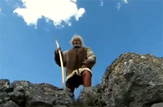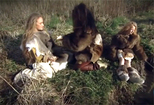“Let’s see who can can explain me this. When it’s said that two individuals belong to the same species, it’s in the case that they can reproduce and create fertile offspring, right? Now, if Neanderthals and sapiens could reproduce, and their descendants, then they belonged to the same species, right?.”
“Can a dog breed with a wolf? The answer is yes and in fact this hybrid can be reproduced with another dog without problems, because, its genome is similar between the two species, in the case of humans, the Neanderthals and sapiens had a common ancestor, Homo antecessor (currently science considers it a variety of Erectus until further confirmation).
In cultural terms, the Neanderthals buried their dead, primitive sapiens, did not.
The term “species” is subjective and therefore subject to personal interpretation, and humans has not been able to discern whether Neanderthals and sapiens were different species or different races of the same species.
The theory of the Neanderthals disappearing because of sapiens is not well sourced, even less when a genetic study of the world’s population now determined that the human race descended from a group of a few thousand humans 27,000 years ago. “
And, how funny is how they mounted an evolutionary history out of 16 individual bones..
“How could a hominid, considered clumsy and unintelligent know how to hunt in group, with spears and arrows, know fishing, know tanning the hides of the animals he hunted to use as shelter, make tools of bones, wood and stones, pipes and drums, and bury their dead?
It is also said that they could not speak and only emit guttural sounds like monkeys. How can one think that of a so advanced being , who lived in clans, knew the fire, cooked and collected berries?
How it is possible that the first scientists, when analyzing the remains of our ancestors, deducted “skillfully” that Neanderthals were hairy as chimps only by the remains of incomplete diseased Neanderthal skeletons .
Nothing further! All of these assumptions are based on bodies deformed by osteoarthritis, and remains of children.”
Plus, there are evidences of intentional burial, perhaps some grave goods, and also evidence that babies and infants were buried in shallow pits, and others in natural fissures as well as shallow excavated graves.
They also had social strategies; Neanderthals apparently lived in small nuclear families. There is clearly evidence for some amount of social networking, including interaction between family or neighboring groups.
Marks on animal bones are known to have been created by Neanderthals. A recent find in France appears to be a purposefully chipped face.
Last month a study led by the Gibraltar Museum and published in PLOS ONE documented a multitude of fossil remains of bird wings, particularly from big black raptors, at Neanderthal sites in southern Europe. The team suggested that Neanderthals could have been plucking feathers from the wings for personal use or even for ritual ornaments.
They used pigments and may have made jewelry; some made complex tools. “We know they buried their dead,” Stringer said. In 2010, researchers from the Smithsonian Institution even found evidence that the Neanderthal diet included a diverse mixture of plants, and that they cooked some of the grains. (Related: “Neanderthals Ate Their Veggies, Tooth Study Shows.”)
“Neanderthals have gone from being different from us to being like us,” Hawks noted. “They’re looking like [Homo sapiens] hunter-gatherers look.”
They also had social strategies; Neanderthals apparently lived in small nuclear families. There is clearly evidence for some amount of social networking, including interaction between family or neighboring groups.
Marks on animal bones are known to have been created by Neanderthals. A recent find in France appears to be a purposefully chipped face.
Last month a study led by the Gibraltar Museum and published in PLOS ONE documented a multitude of fossil remains of bird wings, particularly from big black raptors, at Neanderthal sites in southern Europe. The team suggested that Neanderthals could have been plucking feathers from the wings for personal use or even for ritual ornaments.
They used pigments and may have made jewelry; some made complex tools. “We know they buried their dead,” Stringer said. In 2010, researchers from the Smithsonian Institution even found evidence that the Neanderthal diet included a diverse mixture of plants, and that they cooked some of the grains. (Related: “Neanderthals Ate Their Veggies, Tooth Study Shows.”)
“Neanderthals have gone from being different from us to being like us,” Hawks noted. “They’re looking like [Homo sapiens] hunter-gatherers look.”
 RSS Feed
RSS Feed


